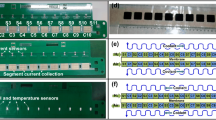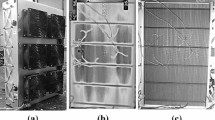Abstract
This paper proposes a real time monitoring method of the status of flooding and drying out of a proton exchange membrane in a Polymer Electrolyte Membrane Fuel Cell (PEMFC). The PEMFC stack is modeled using the simplified Randle’s equivalent electrical circuit. The measured stack voltages after a step current consumption provides the criterion for the water balance condition in the PEMFC. The voltage response has different characteristics in drying out and flooding conditions and it is possible to find membrane resistance and activation resistance corresponding to the equivalent circuit model. Since these resistance elements show a different behavior in each of the water balance states, it is possible to judge the water balance condition in the PEMFC. Furthermore, this method requires no additional costly equipment and needs only simple signal processing. The proposed method is applied to a PEMFC stack operating in normal, drying, and flooding conditions, with the results verifying that the new method can monitor the water contents of the stack.













Similar content being viewed by others
Abbreviations
- \({\text{A}}_{\text{c}}\) :
-
Catalyst specific area, cm2/mg
- a:
-
Transfer coefficient
- BOP:
-
Balance of plant
- \({\text{C}}\) :
-
Double layer capacitance
- \({\text{E}}_{\text{c}}\) :
-
Activation energy, 66 kJ/mol
- F:
-
Faraday’s constant, 96,487 C/mole pressure
- h:
-
Relative humidity of reactants
- I:
-
Current density, A/cm2
- \({\text{I}}_{0}\) :
-
Exchange current density, A/cm2
- K:
-
Ion conductivity
- \({\text{L}}_{\text{c}}\) :
-
Catalyst loading, mg/cm2
- \(\mu\) :
-
Number of moles of a water molecule compared to \({\text{SO}}_{3}^{ - }\) in electrolyte membrane
- n:
-
Number of electron per molecule of hydrogen, 2
- P:
-
Pressure, kPa
- \({\text{R}}_{\text{a}}\) :
-
Activation resistance
- \({\text{R}}_{\text{m}}\) :
-
Membrane resistance
- \({\text{R}}_{\text{u}}\) :
-
Universal gas constant, 8.314 J/mol/K
- T:
-
Temperature, K
- t:
-
Thickness of electrolyte membrane
- \({\text{V}}_{\text{R}}\) :
-
Voltage drop by membrane resistance
- \({\text{V}}_{\text{C}}\) :
-
Voltage drop by membrane and double layer capacitance parallel circuit
- α:
-
Initial voltage value for the given step current, α
- β:
-
Initial current value
References
Onanena, R., Oukhellou, L., Côme, E., Candusso, D., Hissel, D., & Aknin, P. (2012). Fault-diagnosis of PEM fuel cells using electrochemical spectroscopy impedance. IFAC Proceedings Volumes, 45, 651–656.
Andreasen, S., Jespersen, J., Schaltz, E., & Kær, S. K. (2009). Characterisation and modeling of a high temperature PEM fuel cell stack using electrochemical impedance spectroscopy. Fuel Cells, 9, 463–473.
Webb, D., & Møller-Holst, S. (2001). Measuring individual cells voltages in fuel cell stacks. Journal of Power Sources, 103, 54–60.
Ramschak, E., Peinecke, V., Prenninger, P., Schaffer, T., Baumgartner, W., & Hacker, V. (2006). Online stack monitoring tool for dynamically and stationary operated fuel cell systems. Fuel Cells Bulletin, 2006, 12–15.
Fouquet, N., Doulet, C., Nouillant, C., Dauphin-Tanguy, G., & Ould-Bouamama, B. (2006). Model based PEM fuel cell state-of-health monitoring via ac impedance measurements. Journal of Power Sources, 159, 905–913.
Kim, J., Jang, M., Choe, J., Kim, D., Tak, Y., & Cho, B. (2011). An experimental analysis of the ripple current applied variable frequency characteristic in a polymer electrolyte membrane fuel cell. Journal of Power Electronics, 11, 82–89.
Steiner, N. Y., Hissel, D., Moçotéguy, P., & Candusso, D. (2011). Diagnosis of polymer electrolyte fuel cells failure modes (flooding and drying out) by neural networks modeling. International Journal of Hydrogen Energy, 36, 3067–3075.
Lebreton, C., Benne, M., Damour, C., Yousfi-Steiner, N., Grondin-Perez, B., Hissel, D., et al. (2015). Fault tolerant control strategy applied to PEMFC water management. International Journal of Hydrogen Energy, 40, 10636–10646.
Owejan, J. P., Gagliardo, J. J., Reid, R. C., & Trabold, T. A. (2012). Proton transport resistance correlated to liquid water content of gas diffusion layers. Journal of Power Sources, 209, 147–151.
Noh, Y., Kim, S., Jeong, K., Son, I., Han, K., & Ahn, B. (2008). Modeling and parametric studies of PEM fuel cell performance. Transactions of the Korean Hydrogen and New Energy Society, 19, 209–216.
Acknowledgements
This paper was supported by the Graduate School of Research Program of KOREATECH.
Author information
Authors and Affiliations
Corresponding author
Additional information
Publisher's Note
Springer Nature remains neutral with regard to jurisdictional claims in published maps and institutional affiliations.
Rights and permissions
About this article
Cite this article
Shin, DH., Yoo, SR. & Lee, YH. Real Time Water Contents Measurement Based on Step Response for PEM Fuel Cell. Int. J. of Precis. Eng. and Manuf.-Green Tech. 6, 883–892 (2019). https://doi.org/10.1007/s40684-019-00099-0
Received:
Revised:
Accepted:
Published:
Issue Date:
DOI: https://doi.org/10.1007/s40684-019-00099-0




